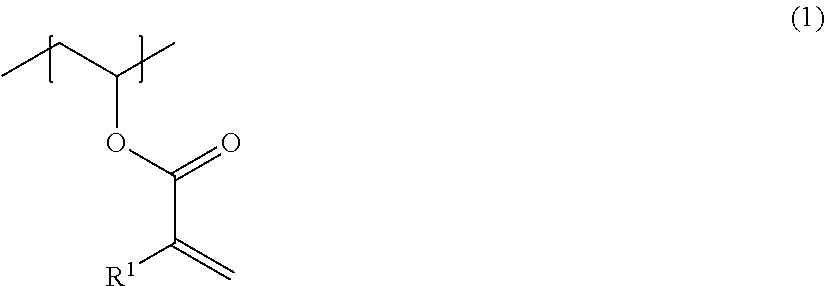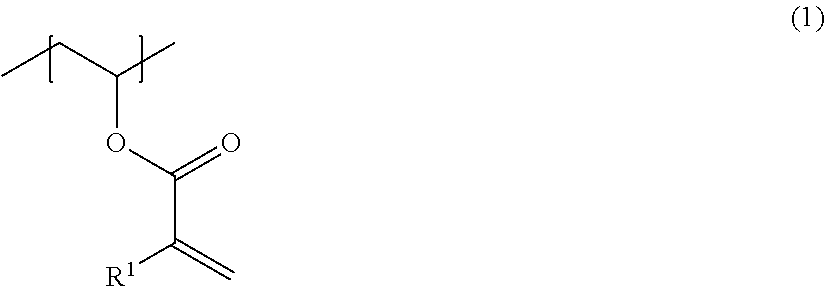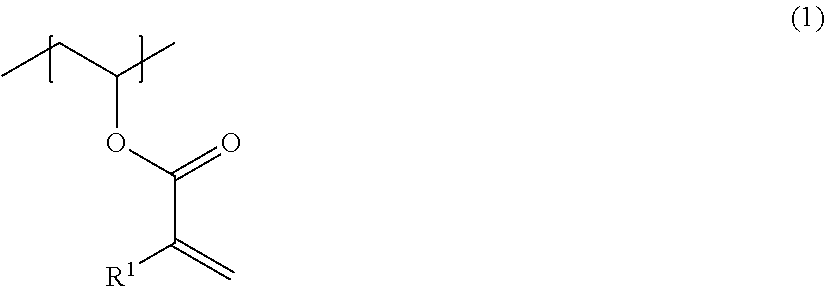Particles containing modified polyvinyl alcohol
a technology of polyvinyl alcohol and modified polyvinyl alcohol, which is applied in the direction of coatings, etc., can solve the problems of bulky side chains of modified polyvinyl alcohols, and achieve the effects of high water solubility, high affinity for photosensitive monomers, and high photosensitivity
- Summary
- Abstract
- Description
- Claims
- Application Information
AI Technical Summary
Benefits of technology
Problems solved by technology
Method used
Image
Examples
example 1
[0058]Into a reactor equipped with a stirrer, a reflux condenser, and an inlet port were charged 315 parts by mass of dimethylsulfoxide, 585 parts by mass of methyl methacrylate, 1.1 parts by mass of phenothiazine, and 1.5 parts by mass of sodium acetate, and with stirring at room temperature, 100 parts by mass of a commercially available polyvinyl alcohol resin (Kuraray Co., Ltd., PVA 5-88) was added. The mixture was heated with stirring to 100° C. and reacted as a slurry for 1.5 hours. Then, the mixture was cooled to room temperature. The content was filtrated to collect a modified polyvinyl alcohol, which was then washed with methanol and then dried at 40° C. and 1.3 Pa for 20 hours, to give target particles. The evaluation results are shown in Table 1.
example 2
[0059]Into a reactor equipped with a stirrer, a reflux condenser, and an inlet port were charged 113 parts by mass of dimethylsulfoxide, 454 parts by mass of methyl methacrylate, 1.1 parts by mass of phenothiazine, and 1.1 parts by mass of sodium acetate, and with stirring at room temperature, 100 parts by mass of a commercially available polyvinyl alcohol resin (Kuraray Co., Ltd., PVA 5-74) was added. The mixture was heated with stirring to 100° C. and reacted as a slurry for 8 hours. Then, the mixture was cooled to room temperature. The content was filtrated to collect a modified polyvinyl alcohol, which was then washed with methanol and then dried at 40° C. and 1.3 Pa for 20 hours, to give target particles. The evaluation results are shown in Table 1.
example 3
[0060]Into a reactor equipped with a stirrer, a reflux condenser, and an inlet port were charged 315 parts by mass of dimethylsulfoxide, 585 parts by mass of methyl methacrylate, 1.1 parts by mass of phenothiazine, and 1.5 parts by mass of sodium acetate, and with stirring at room temperature, 100 parts by mass of a commercially available polyvinyl alcohol resin (Kuraray Co., Ltd., PVA 22-88) was added. The mixture was heated with stirring to 100° C. and reacted as a slurry for 3 hours. Then, the mixture was cooled to room temperature. The content was filtrated to collect a modified polyvinyl alcohol, which was then washed with methanol and then dried at 40° C. and 1.3 Pa for 20 hours, to give target particles. The evaluation results are shown in Table 1.
PUM
| Property | Measurement | Unit |
|---|---|---|
| particle size | aaaaa | aaaaa |
| specific surface area | aaaaa | aaaaa |
| particle size | aaaaa | aaaaa |
Abstract
Description
Claims
Application Information
 Login to View More
Login to View More - R&D Engineer
- R&D Manager
- IP Professional
- Industry Leading Data Capabilities
- Powerful AI technology
- Patent DNA Extraction
Browse by: Latest US Patents, China's latest patents, Technical Efficacy Thesaurus, Application Domain, Technology Topic, Popular Technical Reports.
© 2024 PatSnap. All rights reserved.Legal|Privacy policy|Modern Slavery Act Transparency Statement|Sitemap|About US| Contact US: help@patsnap.com










